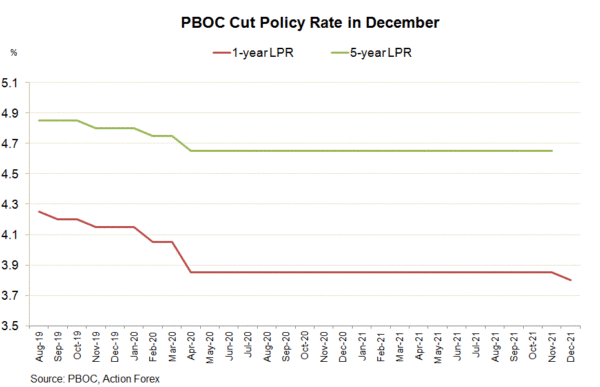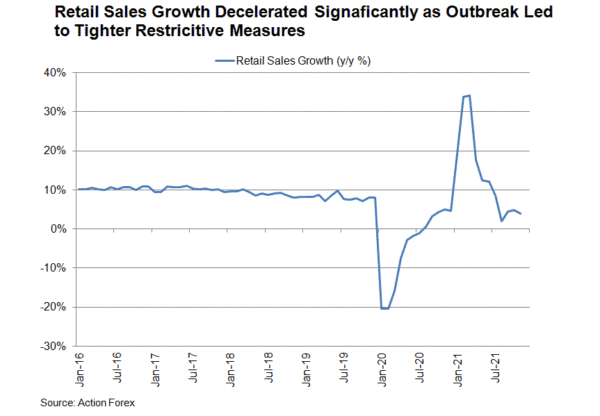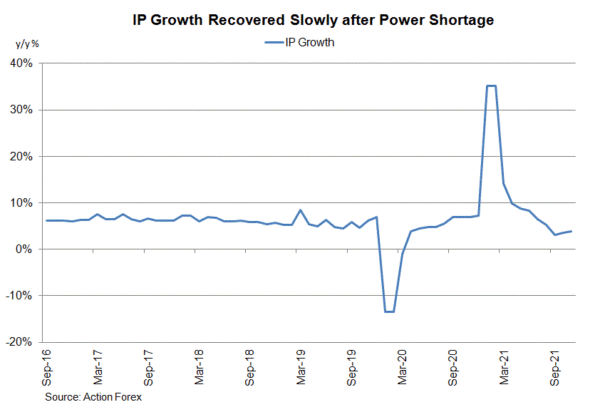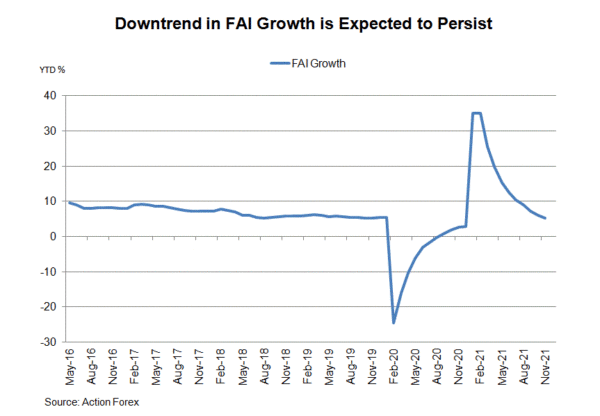China is going against the global tide of normalization of monetary policy. The PBOC announced to cut the one-year loan prime rate (LPR) by -5 bps to 3.8%, first time April 2020. This, together with the reduction in RRR and increase RRR on foreign currencies earlier this month, indicates that the country’s economic recovery is at risk. China’s economic fragility should be attributed to the government’s policy miscalculation, from coronavirus management to the crackdown of major industries.

While the one-year LPR was educed, the 5-year rate stayed unchanged. Before the rate cut, the central bank had already lowered the reserve requirement ratio (RRR) by -50 bps, and raised the foreign exchange RRR by +200 bps to 9% from 7% on December 15. The aims are to increase liquidity in the market and prevent capital outflow, respectively. Economic data has been disappointing. Retail sales expanded +3.9% y/y in November, much weaker than consensus of +4.7% and October’s +4.9%. In the first 11 months of the year, retail sales grew +13.7% y/y, compared with +14.9% in the first 10 months. Industrial production rose +3.8%, slightly better than consensus of +3.7% and +3.5% in October. However, the year-to-date reading gained +10.1%, compared with +10.9% in the first 10 months. Urban fixed asset investment remained weak. The year-to-date growth of +5.2% y/y was a deceleration from the +6.1% expansion in the first 10 months of the year.


 The resurgence of the pandemic in China has resulted in more stringent restrictive measures, thanks to the government’s obsession in COVID-zero. This clearly has weighed on consumer activity (evidenced in retail sales). The labor market also suffered as the sectors affected most seriously by the restrictions are usually the labor-intensive ones such as catering and factories. Power shortage leading to closure of factories lingered despite improvement from situation in September/October. One of the key reasons for the power shortage is the pricing problem in China’s power industry. As China’s electricity prices have been controlled by the government, grid firms (suppliers) find themselves worse off amid a global surge in commodity prices. Their restricted supply of electricity to the market is a cause of the recent power shortage in China.
The resurgence of the pandemic in China has resulted in more stringent restrictive measures, thanks to the government’s obsession in COVID-zero. This clearly has weighed on consumer activity (evidenced in retail sales). The labor market also suffered as the sectors affected most seriously by the restrictions are usually the labor-intensive ones such as catering and factories. Power shortage leading to closure of factories lingered despite improvement from situation in September/October. One of the key reasons for the power shortage is the pricing problem in China’s power industry. As China’s electricity prices have been controlled by the government, grid firms (suppliers) find themselves worse off amid a global surge in commodity prices. Their restricted supply of electricity to the market is a cause of the recent power shortage in China.
PBOC’s rate cut is contrary to the trend of monetary policy normalization in global major central banks. The policy divergence could lead to weakness in renminbi. While it might be of the interest of the China’s government ib t he near-term, it could be detrimental to investors’ confidence in the currency and economic situation in the country in the longer-term.














